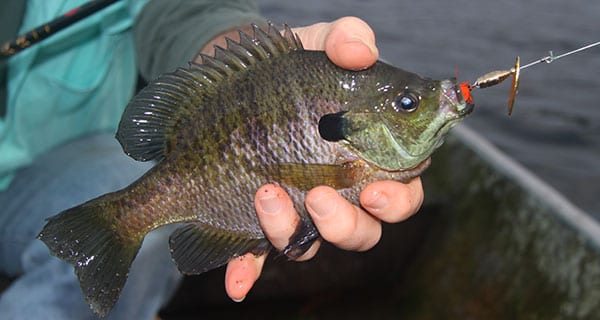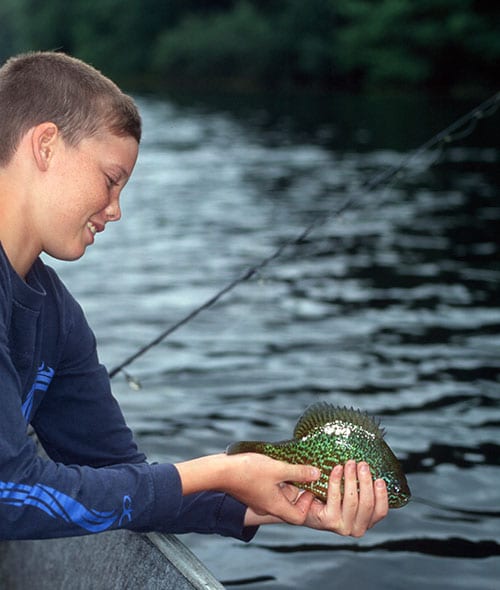
By Tom Schlichter
After a cold, cold winter, you can bet your last piece of aged firewood that local anglers will be chomping at the bit to get a new fishing season started. While fluke, stripers and newly stocked trout will clearly be the local favorites as the weather finally takes on the feeling of spring come later April and May, panfish offer a March alternative – one that can warm your heart with fast action and plenty of fun for a minimum investment of time, money and effort. Bring along a child or novice angler to sample the action with bluegills, pumpkinseed, yellow perch and crappies and you might even hook another fishing partner for the days ahead.
The waters of March are still generally cold so expect to find panfish holding just outside the shallows when starting out. Look for water that is three to six feet deep at the edge of a cove or flat, or directly out in front of an outflow dam. To really do a number on early season panfish, step down from typical freshwater setup to a lightweight 4-pound test spinning outfit. Light-weight gear allows for long casts off the bank, ensures you’ll feel the slightest nibble, and allows presentation of tiny offerings that are just the right size for a sunny or perch to ingest as it emerges from winter’s grasp.

Rigging up is best kept simple. Start by placing a 2- to 2-1/2-inch, torpedo shaped weighted foam float on your line 1 to 3 feet above where your hook will be positioned. Aerodynamic and weighted, this style float will help carry your line far off the bank when you cast. Its position above the hook should be set to keep your offering about a foot above the bottom or six inches above the tops of any weed beds you’ll be targeting.
Next, tie a small grub or tube lure to the end of your line using an improved clinch knot. Choose either a 1/48-ounce minnow-shaped head or a 1/32-ounce tube bait head. Now slide on a body and you’re set to go. For the body, choose a small grub or tube measuring 1-1/2 to 2-inches in length. Dark colored lures seem to work best with Squirmin’ Squirts and Berkley Power Grubs being excellent choices in pumpkinseed, pumpkin with chartreuse tail, or black with chartreuse tail patterns. While any of these lures can entice the fish on their own, they work even better if tipped with a wax worm, a half-inch-long section of night crawler or, best of all, a single grass shrimp if you can find some clinging to the bulkheads in a local tidal creek.
Once rigged and ready to go, simply cast out, allow the jig to settle for a minute or two, and then begin a slow and steady retrieve. The idea is to glide you lure past the fish. If the wind is blowing, you might choose to let your float drift over productive water rather than reel it home. A slow drift can be deadly, especially if the wind is blowing your float and lure right back toward your feet. Simply reel in any slack as your floats moves inshore. As a rule, the calmer the water, the deeper the fish will hold and the slower you’ll need to retrieve. Add in a slight twitch or two now and then to entice following fish.
Bites are generally subtle with the float and tube lure approach. Usually they register as a slight tilt or twist of the float. Sometimes they simply hold the float in place. If you notice any change in the movement of the float, tighten up on your line and use a light flick of the wrist to set the hook.

As March slips into April, panfish action continues to intensify and the fish steadily grow more aggressive. Now is the time to fool around with small spinners, tiny plugs and even the long wand. At the start of the month, the biggest fish will still be on the edge of deep water, but they’ll move up into the shallows at midday if the sun is bright, and they might just stay there all afternoon if the water continues to warm.
To score at this point, shift to the deeper edge of shallow flats, tie on an in-line spinner, and target the season’s first wakes, rises or fish darting across a sandy flat. Small spinners work best with this approach. I like a size 2 or 4 Panther Martin Classic in all gold, Deluxe Dressed in gold/orange or Regular Fly spinner in silver/white/red. A size 2 Blue Fox Super Vibrex in gold or silver shiner works great, too. No matter which spinner you choose, the key is to work it just fast enough to stay above the newly emerging weeds, or to keep it about 6 inches off the bottom when working across sandy or rocky stretches.
While areas with a little weed growth will begin to gather panfish schools by the end of April, yellow perch tend to stay out in the deeper areas and prefer more open water. That makes them perfect targets when casting in-line spinners or small, 2- to 3.5-inch floating Rapala and Rebel minnow imitations as you can easily work above the weed tops. The same spinner patterns that work with the ‘gills in the shallows will work with the yellows but a kayak or johnboat makes reaching these fish a lot easier. Of course, many lakes are stocked with a fresh round of trout by the time April rolls around. Going with the spinners and lures will tempt these fish to, increasing your chances of success on an overall basis. Generally, though, the trout will be in deeper water, the panfish at the edge of the shallows, and perch – both yellow and land-locked whites – somewhere in between.
Although panfish limits are generally pretty liberal, many anglers release all they catch. Crushing down the barbs on your hooks makes for easy releases, as does bringing along a forceps to grasp and gently remove any hook that has been swallowed past the lips. If you do intend to keep a few panfish for dinner, be sure to check for minimum size limits and maximum creel limits for the location you are fishing. In some instances as are variations in the regulations between sunnies, perch and crappies. Have fun!









